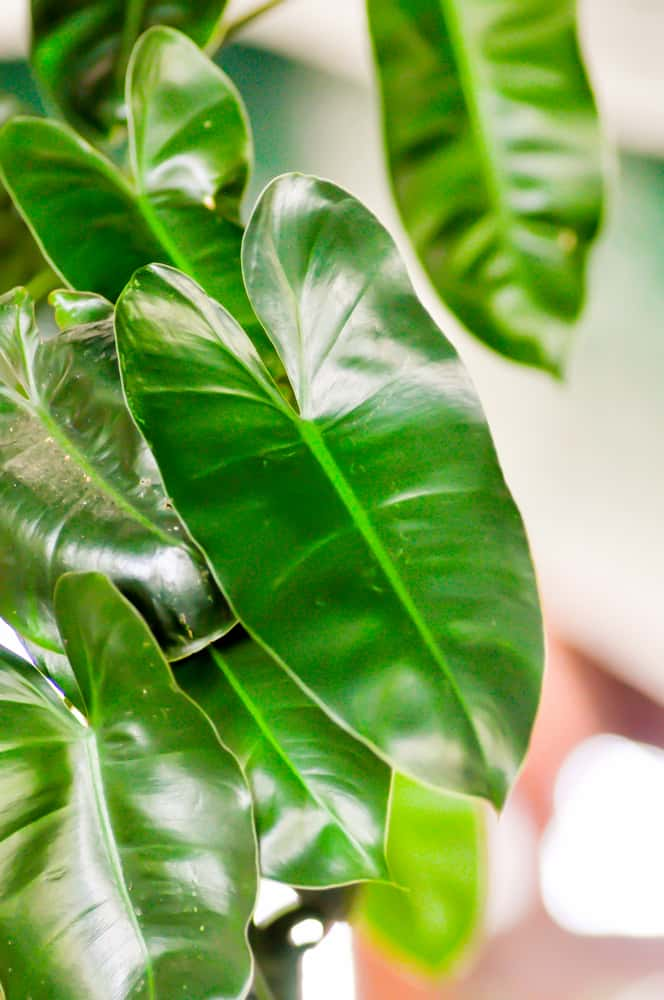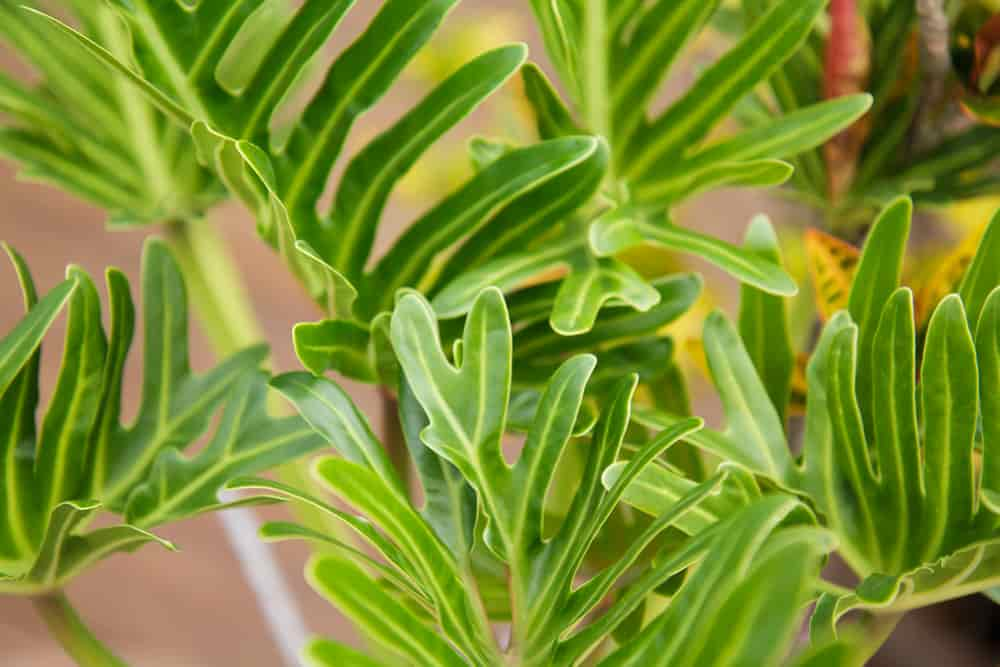Philodendrons are beloved houseplants that can bring interest and texture to any room. They produce stunning foliage that can sometimes require an abundance of nutrients to maintain its growth.
As with other plants, fertilizing philodendron will help keep the plant healthy, while encouraging strong roots and promoting growth.
But not all philodendron fertilizer are created equal, and you can cause harm to your plant with improper fertilization.

Table of Contents
Should you fertilize a philodendron?
Philodendrons need to be fertilized once a month during the plant’s active growing period, which is from spring to summer. The amount of feeding is reduced to once every 6 to 8 weeks in the fall and winter when the plant is dormant.
Just because most people grow philodendrons indoors, that doesn’t mean you shouldn’t fertilize your philodendron.
When fertilizing philodendron, you are giving the plant vital nutrients that it needs for a healthy plant. If they are not fertilized, you may notice a slow down in the growth rate of your philodendron, that its leaves emerge smaller than normal, and the overall health of the plant suffers.
Thankfully, applying a liquid fertilizer with an NPK rating of 20-20-20 will promote healthy growth and a strong root system, both of which are needed for philodendron plants.

When should I fertilize my philodendron?
The philodendron will need to be fertilized throughout the entire year, although you should feed it more when it’s in its growing season. In the spring and summer, fertilize the philodendron once a month and then cut back the feeding to once every 6 to 8 weeks in the fall and spring.
Applying too much fertilizer to the philodendron during its dormant period can cause more harm than good. The plant won’t be able to use up the nutrients, which means they just continue to build up in the soil. It can also upset the growth cycle of the philodendron.
How do I know if my philodendron needs fertilizer?
The easiest way to determine whether or not to apply philodendron fertilizer is to look at the plant’s leaves. When the philodendron’s growth has slowed and new leaves are smaller than older ones, it is a sign that the plant needs feeding.
In most cases, however, if you follow the recommended fertilizing schedule, your philodendron won’t show signs of needing to be fed.
With that said, if you notice any of the above symptoms even when you regularly fertilize the plant, you may not be applying enough or the right type of philodendron fertilizer.

What fertilizer is best for philodendrons?
Philodendrons need a balanced fertilizer with a 20-20-20 ratio. This ratio, called the NPK ratio, lets you know exactly what is in the fertilizer. With a 20-20-20 NPK ratio, that means the fertilizer is 20% nitrogen, 20% phosphorus, and 20% potassium.
Additionally, use a liquid or water soluble feed when fertilizing philodendron and avoid pellet or granular fertilizers. While these types of philodendron fertilizer may seem like a good choice because of their ease of use, they can actually increase the chance of overfertilizing the plant.
My top pick: My recommendation for the best fertilizer for your philodendron is EZ-Gro 20-20-20 All Purpose Liquid Fertilizer. It’s extremely easy to use and has the perfect balance of nutrients for philodendrons.
No matter what brand of philodendron fertilizer you decide to use, always follow the instructions listed on the fertilizer’s label. This will help prevent damage to your plants caused by improper fertilizer use.
Additionally, read and follow the warnings on the label as well to help protect both you and your plant from harm.
Can I use Miracle Gro on philodendrons?
Miracle-Gro will work well on philodendron as long as you select the proper type of fertilizer. Miracle-Gro Indoor Plant Food has equal parts nitrogen, phosphorus, and potassium, which is the type of fertilizer that the philodendron needs.
You can check the latest price here as Miracle Gro is easily one of the est liquid fertilizers for philodendrons that like an equal balance of nutrients.
According to the application instructions, apply one pump directly to the soil for pots smaller than 6-inches or two pumps for pots larger than 6-inches when fertilizing a philodendron.

If mixing in a watering can, add four pumps to one quart of water and then water your philodendron as you normally would.
Miracle Gro offers several different fertilizers for houseplants, such as an all-purpose feed. However, most of these fertilizers are not suitable for philodendrons, and you should always compare the NPK of the fertilizer to the NPK needs of the philodendron before feeding it to your plant.
How to make homemade philodendron fertilizer
When fertilizing philodendron, you don’t necessarily have to use commercially available fertilizer. In fact, there are several common household items that naturally feed houseplants, like philodendrons. These items include eggshells, coffee grounds, green tea, and even fish tank water (also known as fish emulsion).
To use eggshells, simply crush boiled egg shells into as fine of a powder as possible and mix it into the soil. Coffee grounds and green tea can also be sprinkled onto the soil. Just make sure to use used coffee grounds and green tea, and never use fresh.
Compost and worm castings also work well as a more natural philodendron fertilizer. They also make a good soil amendment if you want to naturally increase your soil’s organic content. In fact, there are some commercially available fertilizers that contain worm castings, like this Worm Tea Concentrate.
Can you use aquarium water to fertilize philodendrons?
Dirty aquarium water isn’t healthy for your fish, but it can greatly benefit plants since it is rich in various good bacteria, as well as a wide array of nutrients. Because of this, aquarium water works well to help feed philodendrons. It contains nitrates, which is a form of nitrogen that is easy for plants to absorb.
To use the aquarium water for fertilizing philodendron, simply use the water from the fish tank in place of your regular water choice. Keep in mind, however, that you will need to supplement the aquarium water with other items to ensure your philodendron gets all the required nutrients it needs.
FYI: Remember that not all water from all fish tanks is suitable as a philodendron fertilizer. You should never use fish tank water that comes from salt water aquariums as this extra amount of salt can damage the philodendron. Instead, only use water from fresh water tanks to water and fertilize your philodendron.
How to fertilize a philodendron
Fertilize the philodendron once a month during the spring and summer months with a liquid or water soluble 20-20-20 fertilizer. Reduce the amount of fertilizer in the fall and winter to only feeding your philodendron once every 6 to 8 weeks.
To help prevent damage caused by too much fertilizer, some gardeners prefer to reduce the fertilizer by half strength, such as applying 1/2 teaspoon instead of a full teaspoon, for the first three applications of the year. This can help prevent damage to the plant by applying too much fertilizer.
While fertilizing philodendron is an important part of growing the plant, take care not to over fertilize the plant. Adding too much fertilizer can cause irreversible harm to your philodendron and could even kill the plant.
Are philodendrons heavy feeders?
Because they need to be fed once a month during their active growing season, philodendrons are considered heavy feeders. Thankfully, the best philodendron fertilizer is one with a 20-20-20 NPK that is liquid or water soluble, and is readily available at garden centers, nurseries, and home improvement stores.
Even though philodendrons do benefit from regular feeding, you still need to take care not to over feed this plant.
Over-fertilizing philodendrons will interfere with the plant’s ability to absorb nutrients, while slowing down or completely stopping its growth. Additionally, the leaves and the roots of the philodendron will become discolored and damaged.

Can you over fertilize a philodendron?
Over-fertilizing is, unfortunately, not an uncommon occurrence when fertilizing philodendron. To make matters worse, applying too much fertilizer can severely harm plants and make them vulnerable to diseases and pests. If the over-fertilizing continues, it can be fatal to your philodendron.
Along with over-fertilizing philodendrons, you can also damage the plant by using a low-quality fertilizer. A tell-tale sign of a low-quality fertilizer is that it won’t indicate the NPK rating on the label. Additionally, it is recommended to research the brand of fertilizer and even read reviews left by other customers before using the chemical.
Pro tip: Doing your due-diligence before using any philodendron fertilizer will go a long way to keep your houseplant safe and healthy for years to come. If you’re not sure what brand of fertilizer to get for your philodendron, speak to an associate at your local nursery or reach out to your local plant club to get recommendations.
What are the signs of over fertilizing a philodendron?
The most common signs that you have overfertilized your philodendron are wilting and yellowing of the lower leaves, leaf margins and tips turning brown, roots that are black or brown and limp, slowed or no growth, and a white or silvery crust of excess fertilizer collecting on the surface of the soil.
Your may also notice that your philodendron’s leaves are curling, which is another giveaway that there is an issue.
If your philodendron is showing signs of over fertilization, immediately stop all future feedings until you get the issue under control. If the plant has an abundance of fertilizer built up in the soil, you may have to flush the excess fertilizer out of the philodendron’s soil several times before the problem is fixed.
While you should never aim to over-fertilize your philodendron, it is not the end of the world if you accidentally feed the plant too much and, in most cases, flushing the soil will correct the issue without long-term damage to the philodendron.
How to fix an over fertilized philodendron
The most efficient and successful way to fix an over fertilized philodendron is to flush out all excess nutrients from the plant’s soil. This process is called leaching and will require placing the plant into a tub, sink, or other area where water can drain freely and then water long and deeply.
You may need to repeat the leaching three or four more times to completely flush out all the excess nutrients.

Allow the water to drain completely out of the philodendron’s pot and do not fertilize again for at least one month. If the symptoms continue, try repeating the leaching process a few more times to ensure all excess nutrients have been flushed out of the philodendron’s soil.
Once you have the problem fixed, take the necessary precautions to prevent over-fertilization from occurring again. Additionally, make sure to use liquid fertilizer and not a slow release fertilizer as these products can increase the chance of over-fertilizing occurring.
How to prevent over fertilizing philodendron
There are several things you can do to help protect your philodendron from over-fertilization. The first thing to do is ensure your pot has drainage holes located at the bottom. Poor drainage causes a slew of problems, such as encouraging over-fertilization and over-watering, and increasing the chance of fungal disease.
Another way to prevent over-fertilization is to use a liquid fertilizer and not the granule or pellet form. Granule and pellet fertilizers are designed to reduce the amount of fertilization you have to do because they release the nutrients slowly over time.
However, this means you cannot control the amount of nutrients it gets, which increases the chance of over fertilizing philodendron.
Regularly leaching the philodendron can also help prevent over-feeding the plant. A good general rule of thumb is to leach the plant every 5 to 6 months. This will flush excess fertilizer out of the philodendron’s soil and stop the over fertilization in its tracks.
